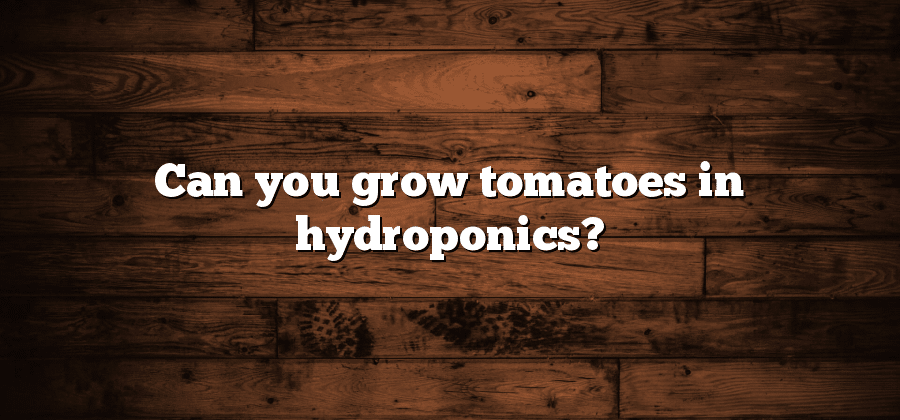Understanding Hydroponic Systems for Tomato Cultivation
Hydroponic systems have revolutionized tomato cultivation, providing a controlled and efficient means of growing these popular fruits. The process involves growing tomatoes without the use of soil, instead, utilizing a nutrient-rich water solution to nourish the plants. This method not only allows for higher yields but also eliminates many of the challenges associated with traditional soil-based farming.
One of the key components of a hydroponic system for tomato cultivation is the use of nutrient solutions. These solutions are carefully formulated to provide all the essential elements required for healthy growth and development. The nutrient solution is continuously circulated through the root system, ensuring that the plants receive a consistent and optimal supply of nutrients. This precise control over nutrient intake allows for faster growth and higher yields compared to conventional farming methods. Additionally, the absence of soil reduces the risk of soil-borne diseases, providing a more hygienic and sustainable approach to tomato cultivation.
Optimal Nutrient Solution for Hydroponic Tomato Growth
To achieve optimal growth and maximize yields in hydroponic tomato cultivation, it is crucial to provide a carefully balanced nutrient solution. Unlike traditional soil-based cultivation, hydroponics requires accurate and precise nutrient delivery to the plants’ roots. The nutrient solution serves as the sole source of essential elements for plant growth, and therefore, it must be formulated to meet the specific nutritional needs of tomatoes throughout their growth stages.
When preparing the nutrient solution for hydroponic tomatoes, it is essential to consider the macronutrients, micronutrients, and trace elements required for healthy plant development. Macronutrients such as nitrogen, phosphorus, and potassium play vital roles in various physiological processes, while micronutrients such as iron, manganese, and zinc are needed in smaller quantities but are equally important. By ensuring an appropriate balance of these nutrients, growers can promote vigorous vegetative growth, strong root development, and optimal fruit production. Additionally, the pH level of the nutrient solution should be carefully monitored and adjusted, as tomatoes prefer slightly acidic conditions for proper nutrient uptake.
Choosing the Best Growing Medium for Hydroponic Tomatoes
To successfully grow tomatoes using hydroponic systems, selecting the right growing medium is crucial. Unlike traditional soil cultivation, hydroponics relies on the growing medium to provide essential nutrients and support for the plants. There are several options available for hydroponic tomatoes, each with its own advantages and considerations. Let’s explore some of the most common choices.
One widely used growing medium for hydroponic tomatoes is coconut coir. Made from the outer husk of coconuts, coir is an organic material that boasts excellent water retention properties while still providing adequate aeration for plant roots. It is lightweight, easy to handle, and more environmentally friendly compared to other alternatives. Another popular option is rockwool, a synthetic material composed of spun mineral fibers. Rockwool offers great water retention and drainage capabilities, ensuring proper oxygenation of the root system. It is a clean and sterile medium, reducing the risk of disease and promoting healthy plant growth.
Providing Adequate Lighting for Tomato Plants in Hydroponics
In hydroponic tomato cultivation, providing adequate lighting is crucial for the successful growth and development of the plants. Since hydroponic systems do not rely on natural sunlight, artificial lighting becomes paramount in ensuring that tomatoes receive the required amount and quality of light for photosynthesis.
There are various types of artificial lights that can be used for tomato plants in hydroponics, including LED grow lights, high-intensity discharge (HID) lamps, and fluorescent lights. Each type has its own advantages and considerations. LED grow lights, for example, are energy-efficient and can be customized to emit specific wavelengths of light that are most beneficial for plant growth. On the other hand, HID lamps are known for their high intensity and ability to penetrate deep into the plant canopy. Fluorescent lights, although less intense, are suitable for smaller-scale hydroponic setups or seedling propagation.
When selecting the appropriate lighting system for hydroponic tomatoes, factors such as light intensity, spectrum, and duration must be considered. Light intensity should be tailored to the growth stage of the plants, with higher levels during vegetative growth and lower levels during flowering and fruiting. The light spectrum should provide a balanced combination of red and blue wavelengths, as these are the most essential for photosynthesis. Additionally, the duration of light exposure should mimic natural sunlight, typically ranging from 12 to 16 hours per day.
Maintaining Proper Temperature and Humidity Levels for Tomatoes
Maintaining optimal temperature and humidity levels is crucial for ensuring healthy growth and maximum yield in hydroponic tomato cultivation. Tomatoes are particularly sensitive to fluctuations in temperature and humidity, which can adversely affect their development and overall productivity.
In terms of temperature, it is important to keep the growing environment within the ideal range of 70-85°F (21-29°C) during the day and slightly cooler at night. This mimics the conditions tomatoes would experience in their natural habitat and promotes optimal growth. Temperature control can be achieved through the use of ventilation systems, fans, and air conditioning units. It is also important to monitor for any temperature extremes, as excessively high temperatures can lead to wilting and blossom drop, while prolonged exposure to low temperatures can stunt growth and delay fruit ripening.
Humidity levels also play a vital role in the success of tomato cultivation. Tomatoes prefer a relative humidity (RH) range of 40-70%. Higher humidity can increase the risk of diseases such as powdery mildew, while lower humidity can inhibit proper transpiration and nutrient uptake. Regular monitoring of humidity levels and the use of dehumidifiers or humidifiers can help maintain the ideal RH range for optimal tomato growth.






